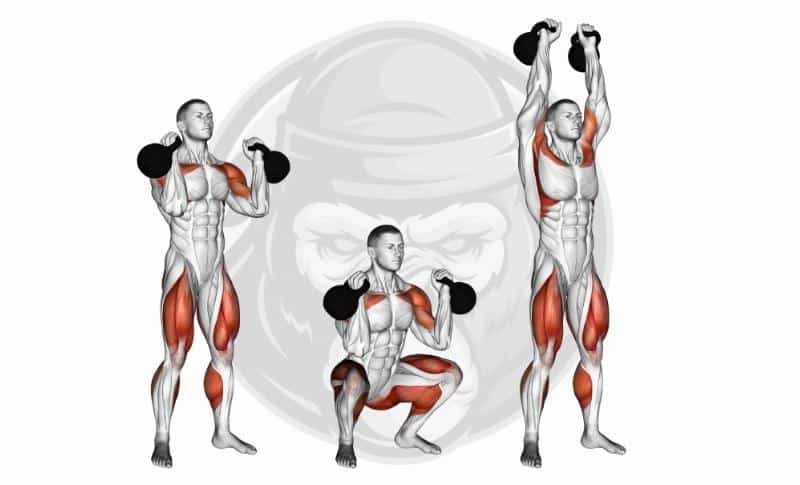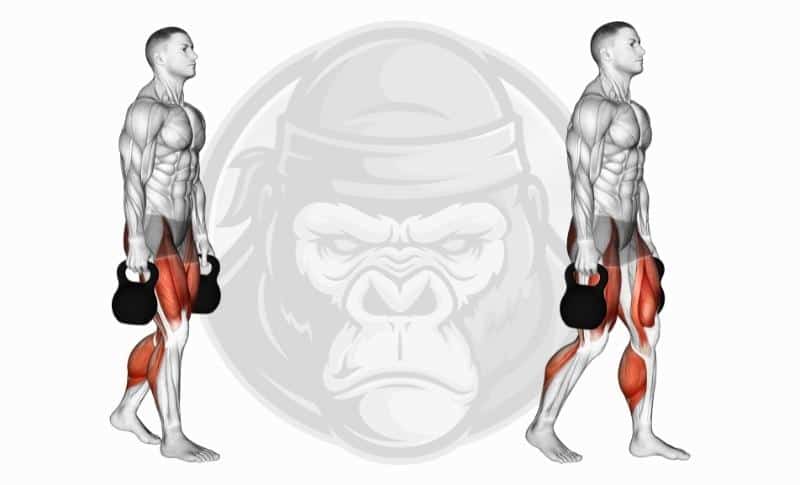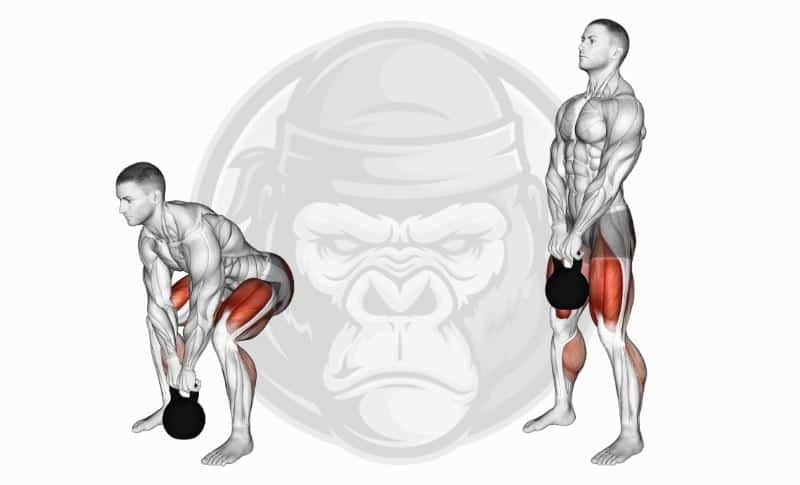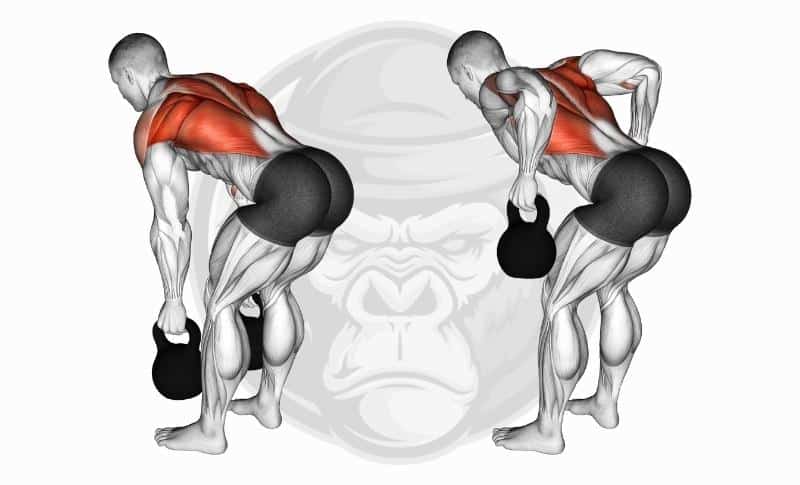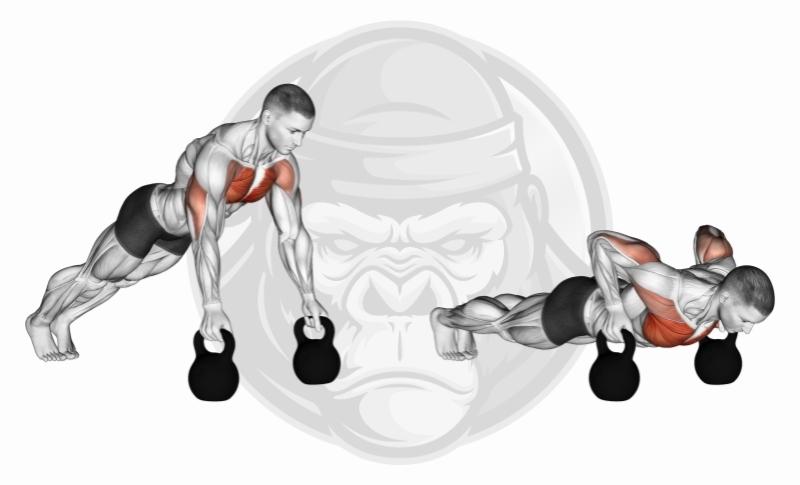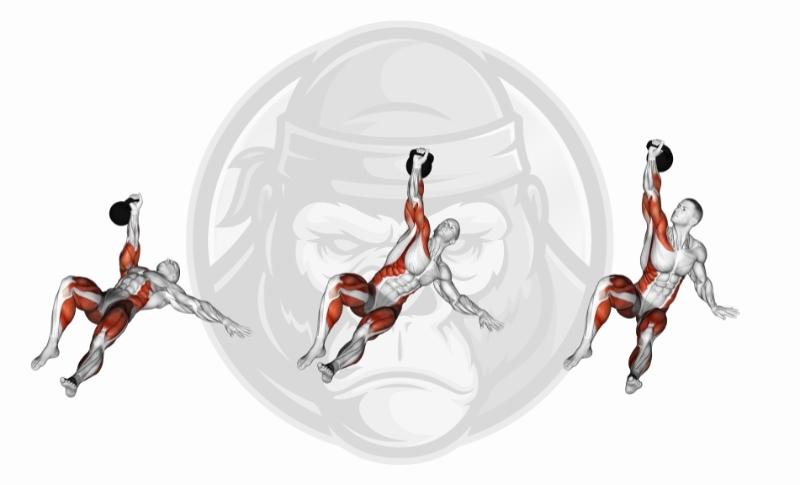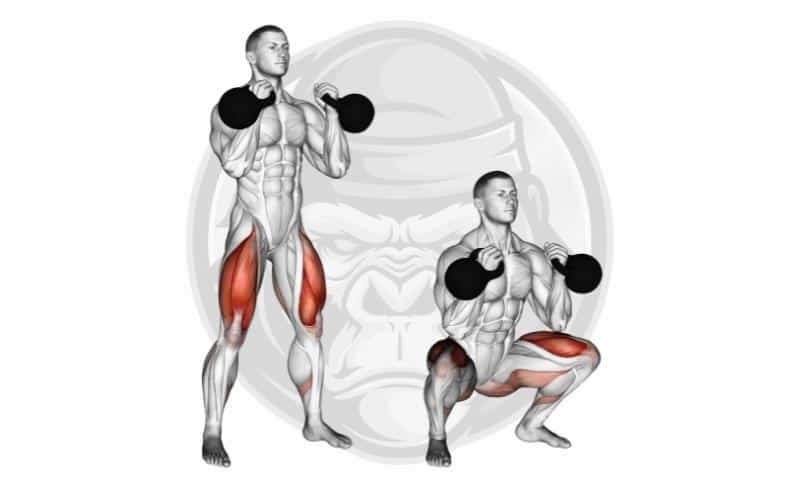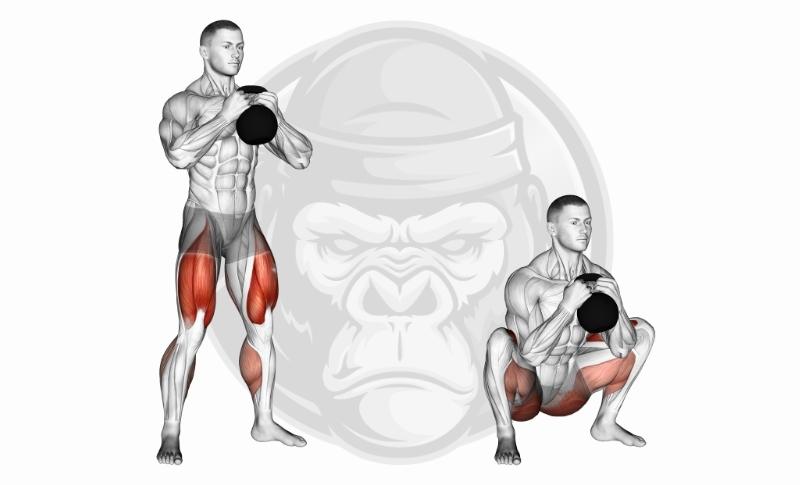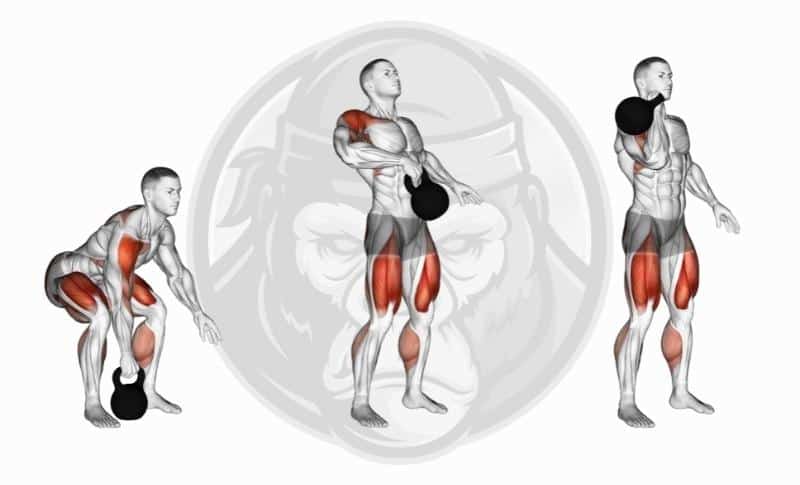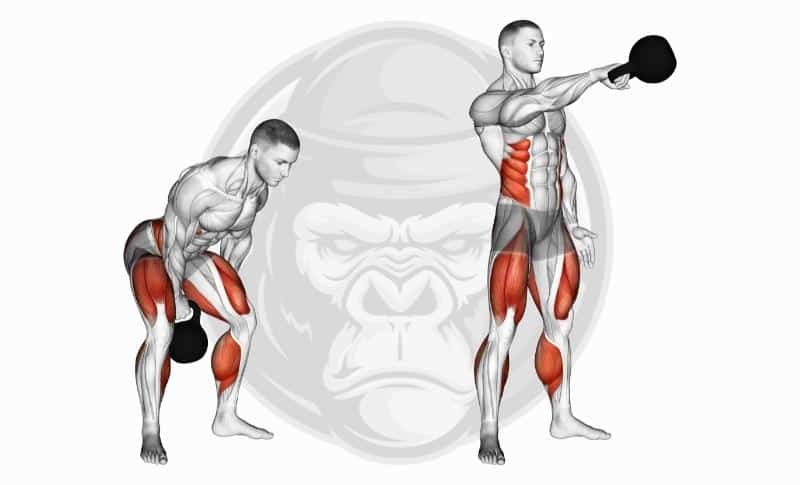Training
The 10 Best Kettlebell Exercises
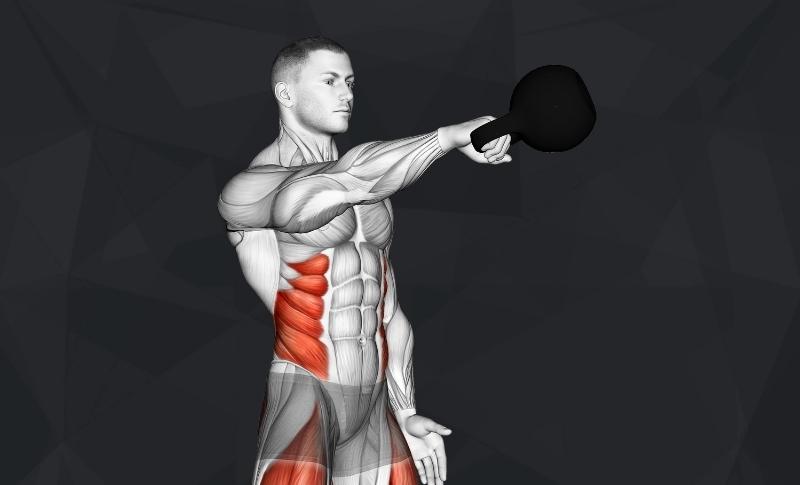
What are the best kettlebell exercises?
Kettlebells are one of the most versatile pieces of training equipment you can own.
The best kettlebell exercises can give you a full-body workout and target muscles throughout your upper and lower body.
With dozens of kettlebell exercises available to choose from, it can be overwhelming to decide which ones to include in your routines.
That’s why we’ve put together this list of the very best kettlebell exercises to try.
You’ll find full-body kettlebell exercises that engage your legs, core, and arms, as well as the best kettlebell workouts for beginners.
The 10 Best Kettlebell Exercises
Our exercise routines are created by determining the best exercises for muscle growth, core strength, and overall health and well-being.
Here’s our list of the 10 best Kettlebell exercises:
10. Kettlebell Thrusters
Great for:
Kettlebell thrusters — sometimes referred to as KB thrusters — combine the movements of squats and shoulder presses to form a compound exercise that works a wide range of muscles.
As such, it’s a great addition to an all-body workout for kettlebell fanatics.
How to do it:
You’ll need two kettlebells for this exercise, so grab a pair and follow these instructions:
- Hold the kettlebells by their handles with the weight resting on the back of your shoulders
- Bend your knees slightly, then squat down
- Drive through from your legs and straighten them, extending your arms as you come up and raising the kettlebells over your head
- Squat down and repeat these steps
Why:
The benefits you gain from kettlebell thrusters are extensive and include assisting with stabilization, improving your squats, and overall boosting core strength.
All in all, they’re among the best kettlebell exercises you can try.
When:
Depending on your level of fitness and experience, you can perform kettlebell thrusters daily. Just make sure you don’t overtrain if you’re fatigued from the previous day’s workout.
9. Kettlebell Farmer’s Walk
Great for:
The farmer’s walk with a kettlebell can be incorporated into your workout for a full-body session or on a day when you really want to target your legs.
It’s also very easy to perform, making it ideal for beginners who want to get used to kettlebell routines.
How to do it:
Again, you’ll need two kettlebells for this exercise:
- Hold each kettlebell with your arms down to your sides, squeezing the handles tightly
- Stand up straight and don’t let the kettlebells touch your sides
- Pinch your shoulders and look straight ahead
- Walk forwards with slow steps while keeping your core tight
Why:
While it may seem you’re just walking along holding weight, kettlebell farmer’s walks target more than just your leg muscles.
Triceps, biceps, forearms, and even your hand muscles all get a workout as well.
When:
Kettlebell farmer’s walk exercises work well as part of a core workout, or you can use them as accessory work or even as part of a warm-up routine.
8. Kettlebell Deadlifts
Great for:
If you’re unsure about going all-in with a barbell deadlift, for instance, if you’re concerned about putting out your back, kettlebell deadlifts make for a great substitute.
They work a range of muscles as well as helping to improve coordination and core stability.
How to do it:
Grab a kettlebell of the weight of your choice, then follow these steps:
- Start with your kettlebell lined up between your ankles
- Bend your knees slightly and keep your hips up and hinged with a flat back
- Take the kettlebell and keep your core tight as you stand straight up
- Reverse the movement, lowering the kettlebell back down to the floor
Why:
The kettlebell deadlift gives you a full-body muscle activation workout as well as improving posture.
Muscles throughout the body are targeted, strengthening the posterior chain, including lats, glutes, hamstrings, calves, and core.
When:
If you’re a kettlebell beginner, you should limit the frequency you perform kettlebell workouts as your strength and form improve.
More experienced people may increase the number of times they do this.
7. Kettlebell Rows
Great for:
Kettlebell rows allow you to hone in on a selection of back muscles with a simple to perform exercise.
You can use a light kettlebell when you’re first starting out so you won’t put undue strain on your back while perfecting the form.
How to do it:
Kettlebell rows are relatively easy to perform – here’s how:
- Push your hips backwards and load the heels
- Keep your back straight and legs at shoulder width
- Pick up the kettlebell from the center of the body out to the side towards the hips
- Return the kettlebell to the starting position reversing the previous motion
Why:
Kettlebell rows are another great way of activating a range of muscles, including the trapezius, biceps, and posterior shoulder muscles.
It’s a great move that also gets your core to work as well.
When:
Since kettlebells aren’t loaded with weight in comparison to performing barbell rows, they can be performed regularly as part of a more comprehensive kettlebell routine.
6. Kettlebell Pushups
Great for:
A variation on the traditional pushup, kettlebell pushups involve holding onto a kettlebell rather than placing your hands directly onto the floor.
This brings additional strength to your abdominal, shoulders, and chest.
How to do it:
Follow these simple steps to perform a kettlebell pushup:
- Place the kettlebell on the floor and adopt a plank position with your hands holding the kettlebell
- Bend your arms and lower your body towards the floor with the kettlebell positioned around your upper chest
- Push back up into the starting plank position
Why:
Kettlebell pushups deliver similar benefits you get from regular pushups, engaging the chest, core, pectoral, and leg muscles.
When:
There’s no harm in doing a few sets of kettlebell pushups each time you have a workout, particularly if you want to get a nice all-body session on the go.
5. Kettlebell Turkish Getups
Great for:
If you’re looking for a holistic all-round body motion exercise using a kettlebell, give the kettlebell Turkish getup a try.
Not only does it promote mobility and balance, but it also works a range of muscle groups throughout your entire body.
How to do it:
The kettlebell Turkish getup is a fairly complicated exercise, so make sure you follow these instructions carefully to perform it correctly:
- Lie on the floor in a half-fetal position with the kettlebell next to your shoulder on the side you’re working
- Cradle the kettlebell with both hands, with your working hand gripping the kettlebell while the other hand covers it
- Roll onto your back, placing the kettlebell on your stomach
- Once on your back, push the kettlebell up and over your head
- With your other hand, push your body upwards, so your stomach thrusts up into the air. Keep the kettlebell held up high as you do this.
- Bring your leg under your body, so your knee supports your body weight to free up the other hand as you come up onto one knee
- Rise into a standing position to complete the repetition
Why:
One of the principal benefits of the Turkish getup is improving your posture.
You can also gain greater shoulder stability through holding the weight above your shoulder during the exercise, as well as added benefits for your core strength.
When:
There’s no problem including this in your regular kettlebell training session, provided you’re mindful of taking rest days when necessary to recuperate.
4. Kettlebell Squats
Great for:
Body weight-only squats are the first port of call for someone just starting their training journey.
Introducing the kettlebell squat can be a great way to progress up to a full barbell squat off the rack.
It also works muscles in both the upper and lower body.
How to do it:
Choose the kettlebell with a weight you’re comfortable with, then:
- Hold the kettlebell at chest level using both hands
- Tuck your elbows in and your back straight
- Spread your legs to shoulder width with toes slightly outwards
- Push your hips back, bend your knees and lower your legs until your thighs are slightly below parallel to the floor
- Press through the heel, pushing your hips to return to the starting position
Why:
Kettlebell squats activate both the upper and lower body, with a weight that is easier to manage, particularly if you’re just starting out on your training journey.
When:
Include this exercise if you’re after a great full-body workout with big compound moves or if you want to hit your legs hard.
3. Kettlebell Goblet Squats
Great for:
The kettlebell goblet squat is similar to the traditional kettlebell squat, with the kettlebell held up in front of the chest helping stabilize your trunk during the exercise.
Use this to build up your quads and glutes as well as improve your core stability.
How to do it:
Once you’ve grabbed your kettlebell, follow these steps:
- Hold the kettlebell at chest level using both hands
- Tuck your elbows in and your back straight
- Spread your legs to shoulder width with toes slightly outwards
- Push your hips back, bend your knees and lower your legs until your thighs are slightly below parallel to the floor
- Press through the heel, pushing your hips to return to the starting position
Why:
It’s one of the safest ways to perform a squat, which is perfect for people who might have back issues to contend with.
When:
This is perfect as part of a comprehensive full-body workout, and you really want to hit as many muscles as possible in one exercise.
2. Kettlebell Clean & Press
Great for:
If you want to bring a greater degree of motion and muscle use into a kettlebell workout, the kettlebell clean and press will deliver the goods.
This routine brings in everything from your back and legs through to your shoulders and arms with each rep performed.
How to do it:
There are two primary stages to a kettlebell clean and press, which we’ll run through now:
- Position your feet slightly wider than shoulder-width apart
- Bend slowly into a half-squat, making sure your back remains neutral
- Use your other arm to create balance by holding it out
- Take the kettlebell in your hand with a relatively loose grip
- Lift the kettlebell and drive it towards you as you stand, keeping your arms tucked into your body
- Rotate your arm through the window of the kettlebell and raise it up in the air to the side of your head
Why:
This is another excellent kettlebell exercise that works muscles throughout the body, so if you want to use your bell for maximum impact, this will produce phenomenal results.
When:
Use this exercise as part of a full-body workout, and you’ll start to feel the benefits after just a few sessions.
1. Kettlebell Swings
Great for:
The kettlebell swing is ideal for kettlebell beginners, functioning as a basic ballistic exercise that will train your posterior chain through its simple pendulum motion.
Incorporate this into a warm-up or as part of a full-body session to impact various muscle groups.
How to do it:
The kettlebell swing is a great movement for beginners, so follow these easy steps to deliver a great exercise:
- Place the kettlebell in front of you lined up between your feet
- Bend your legs slightly and reach over to pick up the kettlebell, making sure your back is flat and horizontal
- Grab the kettlebell and pull it between your legs to create momentum
- Drive your hips forwards, straightening your legs to send the bell up to shoulder height
- Allow the kettlebell to swing back down to between your legs and repeat the motion
Why:
An easy-to-learn and efficient full-body exercise, the kettlebell swing gives you a good cardio workout and builds muscles in the legs and arms.
When:
This is a great workout you can use in a range of exercise routines and can even be used as part of a warm-up before hitting harder exercises with heavier weights.
FAQs About Kettlebell Exercises
If you’re still unsure what the best kettlebell exercise is for you, check out our answers to the most frequently asked questions about kettlebell exercises.
Q: Are kettlebells good for beginners?
There are lots of easy to learn exercises for kettlebell beginners, some of which you can find listed above in this guide to the best kettlebell exercises.
You can introduce a great deal of variety to your regular workouts by introducing kettlebells, and the compact nature of a bell makes it easy to take wherever you go.
Q: Are kettlebells harder than dumbbells?
Kettlebells are loaded with potential and can be used to perform exercises that can’t be done with dumbbells.
This range of potential means that there’s a slightly steeper learning curve when it comes to mastering kettlebells, with a greater selection of potential exercises to understand the correct form for.
If you’re new to kettlebells, you’ll find there are plenty of exercises you can learn to get you started.
Make sure you don’t go overboard on the weight, so you can be sure to focus on getting the form right before investing in a heavier kettlebell.
Q: What muscles do kettlebell exercises work?
Kettlebells work a variety of muscles depending on the exercise you’re performing.
A full-body kettlebell exercise is particularly effective for developing legs, arms, and shoulders, for instance, when swinging a kettlebell.
If you’re unsure which exercise to go for or you’re looking to target specific muscles, head back up to the start of this guide, where we’ve broken down which routines deliver the results you’re after.
Q: Do you need two kettlebells?
While some kettlebells exercises require two kettlebells, you can perform plenty of routines with just one.
As you progress, you may want to invest in additional kettlebells of different weights to help you develop additional strength and coordination.
Q: Should I do kettlebells every day?
This really depends on the intensity of your workouts and how your body recovers.
If you are having light-weight, cardio-based workouts each morning, your body won’t have too much trouble recovering.
However, full-body kettlebell sessions on a daily basis are more likely to lead to potential injury.
Use your best judgment and pay attention to your body after each session.
Summary
Kettlebell exercises come in a range of styles and are great for delivering a comprehensive workout with minimal equipment.
This guide should help you to put together a fantastic kettlebell routine that works for each muscle group.
Regular kettlebell sessions are also great for cardio, stamina, and core stability, making them perfect for maintaining good health.
Here’s a quick recap of the 10 best kettlebell exercises:
- Kettlebell Swings
- Kettlebell Clean & Press
- Kettlebell Goblet Squats
- Kettlebell Squats
- Kettlebell Turkish Getups
- Kettlebell Pushups
- Kettlebell Rows
- Kettlebell Deadlifts
- Kettlebell Farmer’s Walk
- Kettlebell Thrusters

